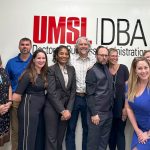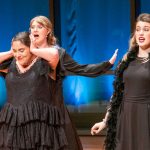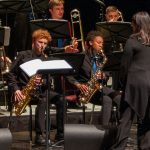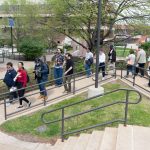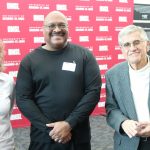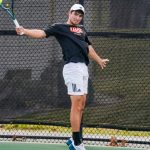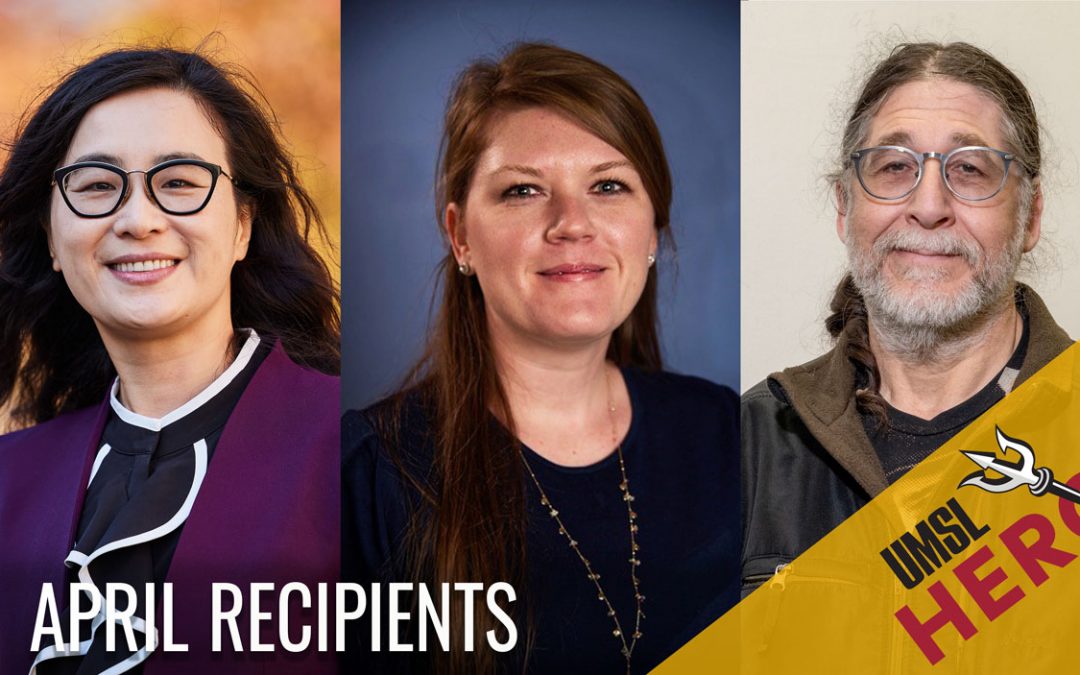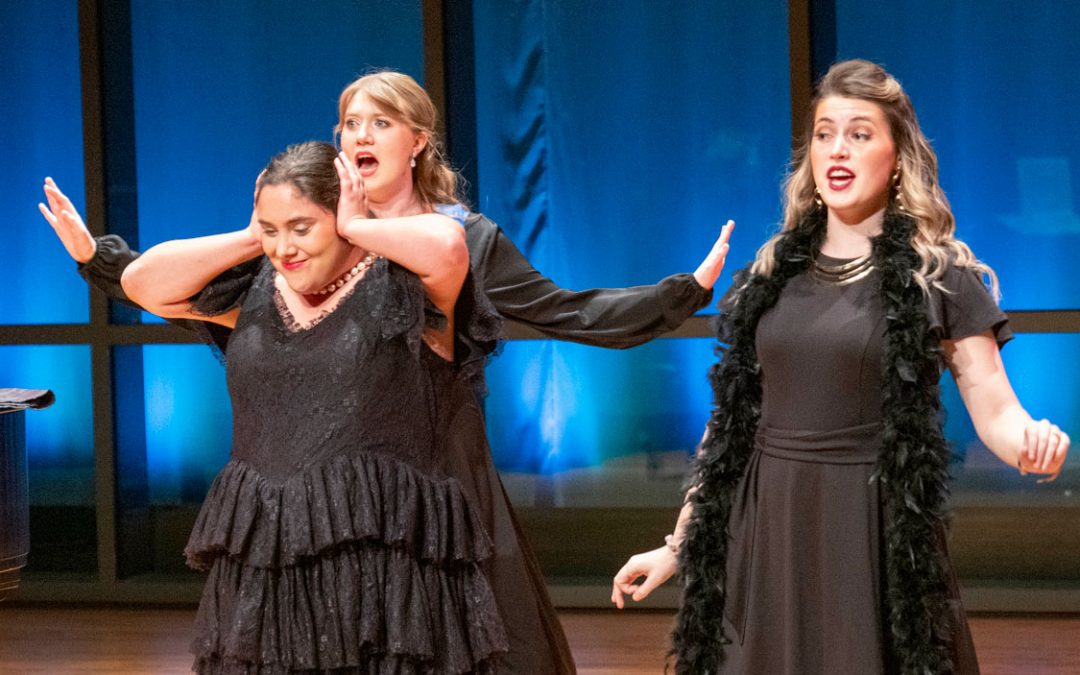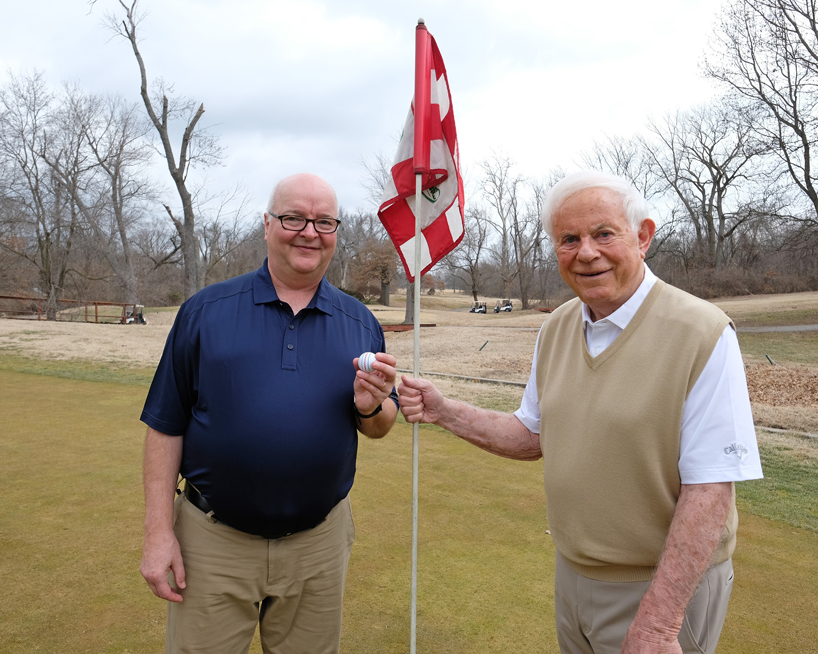
Local entrepreneur Ray Barrett, right, solicited the help of UMSL College of Optemetry Professor and Director of Research Carl Bassi to test the idea that would become his Triple Track golf ball. Through a series of experiments involving laser-embedded golf balls, Bassi and his UMSL colleagues were able to show Barrett’s invention increased putting accuracy by nearly 12 percent from 10 feet out. Callaway licensed has since licensed the design for its line of ERC Soft golf balls, and they were released on Friday. (Photos by August Jennewein)
Ray Barrett knew he was onto something special. The St. Louisan entrepreneur had drawn three lines on his golf balls to help track their flight in the air, only to find that the lines were also having an appreciably positive effect on his putting.
University of Missouri–St. Louis College of Optometry Professor and Director of Research Carl Bassi knew Barrett was onto something as well, especially after running experiments involving ball-embedded lasers, specially designed greens and around 60 golfers to determine that Barrett’s guide lines improved putting accuracy.
It took more than eight years, but Barrett’s invention – with an assist of scientific backing from Bassi and his UMSL colleagues – is finally making it to the marketplace. Golf giant Callaway licensed Barrett’s patented Triple Track technology and added it to the new line of ERC Soft golf balls, which hit shelves on Friday.
“I learned a lot from Ray in terms of that power of persistence and sticking to something and believing that this is going to work,” Bassi said. “This is such a cool thing for UMSL. This is the very kind of thing UMSL does that is often overlooked. UMSL provides services to the community in terms of research. That’s a really important thing, that we’re able to provide expertise when we can to help people in the community.”
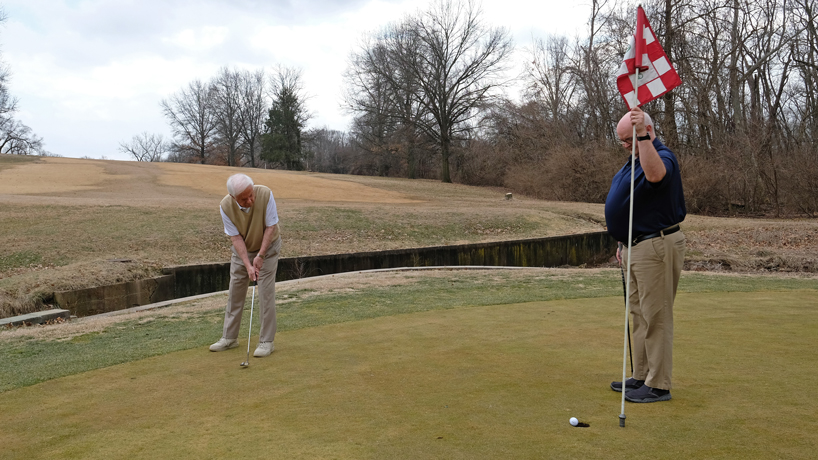
Entrepreneur Ray Barrett sinks a putt with the new Callaway ERC Soft golf ball featuring his Triple Track design as UMSL Optometry Professor Carl Bassi tends the pin at Normandie Golf Club.
Barrett, the founder of international companies Landshire Food Systems and Biomedical Systems, originally conceived of the lines because internet research told him they would help with visibility. He approached Bassi about testing the invention, and Bassi helped identify the phenomenon: vernier acuity, a person’s ability to see discrepancies in alignment among line segments.
Think of the lines on the landing decks of aircraft carriers, designed to guide pilots down safely. The space between the lines on the ball matter, as do the thickness and color of the three lines: a wide red center guide with two thinner, blue flanks.
Phil Mickelson, a five-time major champion, used the ball for the first time in a PGA Tour event at the Desert Classic from Jan. 17-20 in La Quinta, California, and finished in a tie for second at 25 under par. That included a first-round 60 that held up as the low round for the tournament.
“You’re really sensitive to being able to detect whether things are aligned or not aligned, much more sensitive than you are to a standard eye chart,” Bassi said. “That sensitivity is even more than what you can predict based on the anatomy. It tells you there’s neural processing in visual areas of the brain that leads to this improvement in vernier acuity over standard visual acuity.”
Bassi, along with College of Optometry Senior Research Engineering Technician Michael Howe and Wayne Garver, former UMSL research scientist in physics, designed an experiment in which they implanted lasers into golf balls – some with Barrett’s lines, some without. They set up an artificial practice green at Normandie Golf Club and had their test subjects line up putts with both types of balls. They found that aiming accuracy increased nearly 12 percent at 10 feet of distance with Triple Track.
They had the anecdotal evidence. They had the scientific evidence. Jim Holtgrieve, a friend of Barrett’s and former top amateur golfer who played in the U.S. Open and five Masters Tournaments, became an early advocate for Triple Track. He started singing the technology’s praises to some of his connections at Callaway.
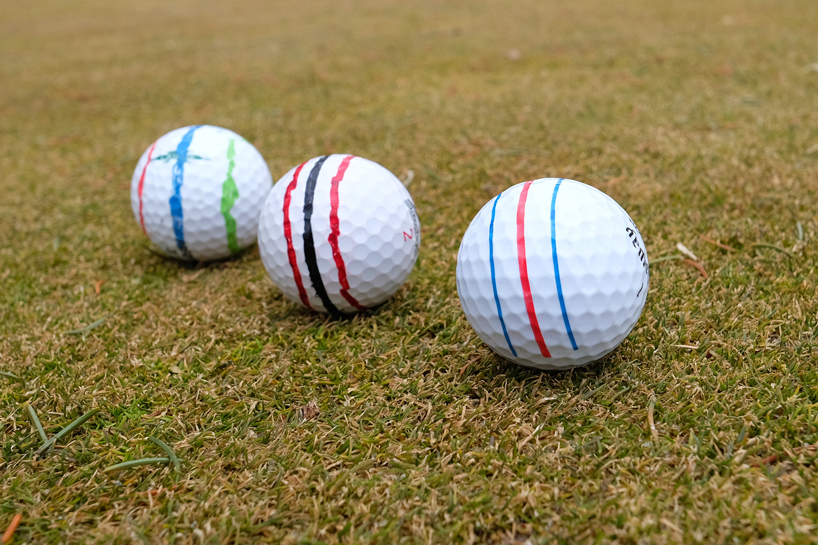
Carl Bassi’s input helped Ray Barrett hone the line width, colors and spacing down to its final version (right) to optimize the effect Triple Track would have on golfers’ aim.
They listened.
“The testing at UMSL reinforced and gave more credibility to my idea, that it wasn’t just in my head,” Barrett said. “It’s a matter of accomplishment, satisfaction and staying with it. We never quit. I had said to myself that there would never be a week that went by without doing something on the golf ball. If I went a week without it, I would think, ‘I’m dropping the ball a little bit.’ Not to use a pun, but that was the idea.”
Callaway is pairing Triple Track technology with a new hybrid cover and graphene-infused Dual SoftFast core that are designed to increase distance on the ERC Soft ball while still maintaining spin and control around the green. The ERC Soft golf balls bear the initials of Callaway Founder Ely Reeves Callaway.
“Other industries develop these great technologies, then we go out and say, ‘Oh, that would be nice to put into this particular industry,’” Petra Petrich, Callaway senior manager for golf ball research and development, said in an interview on the company’s website. “We’ve learned that lining up a putt in our world is very serious, so if you line it up just a few degrees off, you’re missing the putt. It’s a tiny target.
“(The ball has) gotten quite a bit of buzz here, and we’re excited about getting it out to everyone else.”
Bassi said he is excited about the research possibilities that can open up because of his work with Barrett, including further work with vision and golf at Normandie, which UMSL owns. Bassi also felt the experience of working with Barrett, who has acquired the mantel of “the entrepreneur’s entrepreneur” from his various enterprises, gave his students a taste of the entrepreneurship opportunities that could be available through optometry.
“It makes me feel good because I’m sharing the benefits of this invention with my city and UMSL, which is a great university,” Barrett said. “That’s a lot of satisfaction, knowing that I’m not out there by myself on the ship. It was a team effort, and that really is fun. It’s not just about me. It’s about Carl, the school, (College of Optometry Dean) Larry Davis. We’re all in it together. It reaches to everybody.”
Media Coverage
St. Louis Business Journal
KSDK (Channel 5)
KTRS (550 AM) – interview begins at 10:30 mark
Golf Digest


